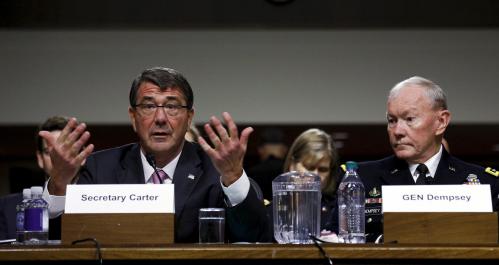The negotiations over the so-called “fiscal cliff” have brought into sharper focus the discussion over how much more, if any, of the nation’s military budget should be reduced as part of comprehensive deficit reduction efforts.
A typical observer can be forgiven some confusion about the current state of play, which extends beyond the defense sequestration threatened by the fiscal cliff. Ten-year cuts already mandated from the 2011 Budget Control Act are described in various places as costing the armed forces $487 billion, $350 billion, or even nothing at all in its core budget. In fact, the $350 billion is the best guide, as it is measured relative to a standard Congressional Budget Office baseline that assumes modest growth for inflation. These are all inflation-adjusted figures and do not include war costs or VA budgets. Sequestration, like the Simpson-Bowles and Rivlin-Domenici deficit reduction commissions of 2010, would cut another $500 billion or so over ten years.
What is a non-specialist to make of all this? Many doves will favor more cuts, finding it persuasive that we still outspend China 3 to 1 (roughly $550 billion in 2013, plus another $85 billion in likely war costs), that we account for more than 40 percent of all global military expenditures, and that we exceed the Cold War U.S. average for defense spending. By contrast, hawks will tend to emphasize that we will soon spend just 3 percent of GDP on the nation’s armed forces, after Cold War norms two to three times that number, and that today’s world remains turbulent and dangerous. Rather than resolve the impasse by such sweeping arguments, however, it would be better to link budget numbers to strategies and capabilities.
The starting point for doing so is the Obama administration’s current military plan. It now incorporates those assumed cuts from the first round of the Budget Control Act (though not from possible sequestration). It will scale down the military from about 1.5 million active-duty uniformed personnel to its pre-9/11 total of 1.4 million, or two-thirds the Cold War norm. It chips away at modernization programs but preserves most major ones, with one or two notable exceptions. It levels off various forms of military pay and benefits. But most troops will continue to be compensated better than private-sector cohorts of similar age, education, and technical skill.
Building on this plan, there are two basic ways to proceed now. One would seek more economies and efficiencies within current national security guidance. The other would revise that guidance fundamentally. I believe the first approach much more prudent, but it is worth explaining what kind of changes would be needed to generate the kinds of additional big savings that some favor. Too many proponents of deeper cuts are getting away with misleading arguments that make such cuts sound relatively painless. They would not be.
The first approach might generate additional savings of $100 billion to $200 billion over a decade (though some of those savings might be counterbalanced by higher-than-expected costs in other parts of the Pentagon budget, so the net savings could be less than some hope). These changes would themselves be hard. For example:
- The size of the active-duty Army and Marine Corps could be reduced modestly below their 1990s levels; current plans are to keep them slightly above those levels;
- Rather than increase its fleet, the Navy could employ innovative approaches like “sea swap,” by which some crews are rotated via airplane while ships stay forward deployed longer, to get by with its current 286 ships or even a few less;
- The F-35 joint strike fighter, a good plane but an expensive one, would be scaled back by roughly half from its current intended buy of 2,500 airframes;
- Rather than design a new submarine to carry ballistic missiles, the Navy might simply refurbish the existing Trident submarine or reopen that production line;
- Military compensation would be streamlined further as well. Stateside commissaries and exchanges might be closed, and military health care premiums increased modestly more.
The other approach, necessary if big cuts like those proposed by the Simpson-Bowles commission are to happen, would require what might be called a strategic shift—a more profound reorientation of America’s role in the world. It would be an overstatement to say that it would emasculate the country, deprive it of superpower status, or require explicit abandonment of any ally. But it would accept substantially greater risk.
I would oppose these larger cuts, but if they proved necessary, two of the least debilitating ways to carry them out might be as follows. The active-duty Army and Marine Corps might be cut by 25 percent, going much further than the administration and depriving the nation of the capacity to conduct anything more than one large ground operation at a time. The active duty Army might wind up with 400,000 soldiers, in contrast to more than half a million now. This would be enough for one major operation, like the unlikely but not unthinkable contingency of another war in Korea. But it would not allow enough capability for that plus an ongoing mission similar to the one in Afghanistan today at the same time. It would effectively move ground force planning away from the two-war standard that has, however imperfectly and inexactly, undergirded American military strategy for decades.
The second major change could be in military compensation. No one likes to talk about this at a time of war, given the amazing service of our all-volunteer force. But with war winding down, perhaps this can be rethought, as long as help for wounded veterans and survivors is left untouched, and if entitlement reform in other parts of the federal budget creates a national sense of shared sacrifice. Military compensation, now $25,000 greater per person than at the start of the Bush administration, might be gradually returned toward 2001 levels.
Each of these initiatives could save $25 billion to $30 billion once gradually phased in, together producing up to $400 billion in ten-year savings. That would get us a long ways towards the $500 billion figure of sequestration or Simpson-Bowles.
Others may see different ways to realize these kinds of savings or challenge details of my calculations. But the point is to have the debate on these terms. It is time we stopped tossing around big defense budget saving numbers like chips in a poker game, or pretending that magical reforms in how the Pentagon does business can quickly yield huge savings painlessly, and instead linked possible savings to changes in military capability and associated impact on our national security.
O’Hanlon is a senior fellow at Brookings and author of
The Wounded Giant: America’s Armed Forces in an Age of Austerity
(Penguin, 2011).



Commentary
Defense Cuts, Big and Small
December 28, 2012